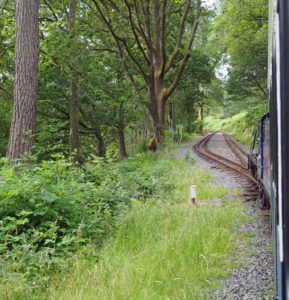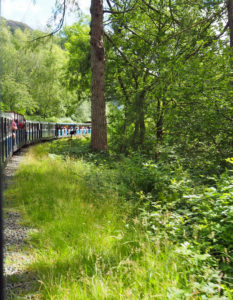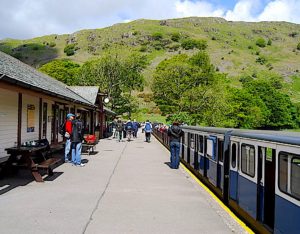Most people begin the journey at Ravenglass. The ride takes about 40 minutes with a 45 minute layover at Dalesgarth.
The trains run with a mixture of open and enclosed carriages. On a dry day, try and get a seat in one of the open carriages. As the rails are only 15” across, the carriages are equally compact. Although they seat four people this is a squash with little room for feet.
Ravenglass is the only coastal village which lies in the Lake District National Park. “Ravenglass station”:https://www.geograph.org.uk/photo/1331973 is next to the “main line station”:https//live.staticflickr.com/4045/4449318032_d2ed46739b_b.jpg n with the the Ratty Arms pub on its platform.
The station is the headquarters of the railway company and their offices are here. The excellent small “museum”:https://www.silvertraveladvisor.com/travel-product/attraction/209520-ravenglass-and-eskdale-railway-museum is in former Furness Railway platform shelter on the main line station. The “Turntable Cafe”:https://ravenglass-railway.co.uk/plan-visit/things-to-do/cafes/turntable/ e is on Platform 1. At the end of the platform are two self catering “camping coaches”:https://www.nationaltrail.co.uk/en_GB/accommodation/ravenglass-eskdale-railway-camping-coaches-elmira-maid-of-kent/
The “turntable”:https://www.geograph.org.uk/photo/1331961 is at the western edge of the platform and this is the zero marker for mileage markers along the line.
There are two loco sheds to the south of the track and a carriage shed to the north. The former Furness Railway stone-built goods shed is now used by the R&ER as a workshop.
From Ravenglass the R&ER line turns eastward and descends past marshland alongside the estuary of the River Mite. Varied bird-life can be seen on the mudflats of the estuary.
The first station is the unstaffed “Muncaster Mill,”:https://en.wikipedia.org/wiki/File:Ticket_Office,_Muncaster_Mill_Station_-_geograph.org.uk_-_1338117.jpg a request stop, where the A595 crosses the line. Next to it is Muncaster Mill, a water-powered corn mill which is now a private house.
From here, the line begins to climb steeply through Mill Wood and alongside the northern edge of Muncaster Fell.
At “Miteside”:https://en.wikipedia.org/wiki/File:Miteside_Halt_-_geograph.org.uk_-_457583.jpg there is a small halt, with a shelter formed by an upturned boat. This is accessible only by public footpath, and was opened to serve residents of nearby Miteside House. The first of the passing loops is here.
There is a small halt at “Murthwaite,”:https://en.wikipedia.org/wiki/Murthwaite_Halt_railway_station#/media/File:Murthwaite_Halt,_Cumbria_(geograph_3331607).jpg accessible only by footpath. The “remains”:https://www.geograph.org.uk/photo/1335421 of the former granite crushing plant at Murthwaite can still be seen and some of the buildings are a permanent way store with its own siding.
Further on, the line reaches an impressive point where it rounds a bluff known as Rock Point, high above the River Mite, before turning down into the valley.
“Irton Road Station”:https://en.wikipedia.org/wiki/File:River_Irt_at_Irton_Road_(geograph_4650659).jpg is the mid-point of the line and is the second passing loop. The station was originally known as Hollowstones after an adjacent farm. The station served the village of Eskdale Green as well as upper Mitedale, and was one of the most important stations on the line. There was a carriage and wagon workshop here used before the newer facilities at Ravenglass were built in 1920. The station building was the only one to be constructed from stone rather than wood and is the only original station structure to survive. Modern additions to the building include a toilet and the radio transmitter for passing messages to and from the trains. The storage shed also survives as well as sidings now used by the permanent way department, serving as a loading point for ballast.
Between Irton Road and Eskdale Green, the railway switches between valleys, leaving the valley of the River Mite and entering Eskdale. “The Green”:https://en.wikipedia.org/wiki/File:The_Green_-_geograph.org.uk_-_1337465.jpg is situated below the village bearing the same name. It was originally known as King of Prussia after the nearby pub. A new station was built by the Preservation Society in 1968.
The line overlooks the valley of the River Esk with isolated farms and begins to climb steeply up Hollin How Bank above the King George V pub.
A halt was built to serve the popular campsite at Fisherground Farm. This is also the site of the third intermediate passing loop. There is also a lineside water tank here, although the water is no longer used for the steam engines since its chemical composition is less suitable for the boilers than mains water.
Beyond Fisherground, the line twists along the valley side, leading to fanciful suppositions that the contractor was paid based on length of railway laid.
In the C19th, “Beckfoot Station”:https://32.cdn.ekm.net/ekmps/shops/071c84/images/beckfoot-railway-station-photo.-ravenglass-eskdale-railway.-3-.-37959-1-p.jpg?w=1000&h=636&v=1 was the last station served by road and was the upper terminus until the line was extended to Dalegarth in the 1920s. It had a goods yard shed and even a chocolate vending machine in the shelter. The “station”:http://www.geog.port.ac.uk/webmap/thelakes/photos/bnj24.jpg is now unmanned and, as it is very close to Dalegarth, passengers will only be picked up on trains travelling between Dalegarth and Ravenglass and will only be set down on trains between Ravenglass and Dalegarth. The line crosses the Whillan Beck here before it joins the River Esk.
The upper terminus of the railway is at “Dalegarth”:https://www.geograph.org.uk/photo/5553004 The current building dates from 2007 and cleverly designed to make use of the railway embankment, with an education/meeting room below the cafe and shop.
There is a run round loop, turntable and sidings. It also has a cafe and shop. The former trackbed of the line to the iron-ore mines at Boot is visible continuing along the valley, and the route can be walked. The upper terminus was originally at Boot but the gradient was too steep for 15” gauge locos and a new station was built at Dalegarth.
It is a short stroll from Dalesgarth to “Boot,”:https://www.silvertraveladvisor.com/review/place/209484-review-boot with its restored water mill and hostelries, the Boot Inn and Brook House Inn .
This is a lovely ride, especially if the sun is shining. To appreiate it to the full, do try and sit in one of the open carriages!
There are more pictures “here.”:https://www.sloweurope.com/community/threads/ravenglass-and-eskdale-railway-cumbria.6016/










